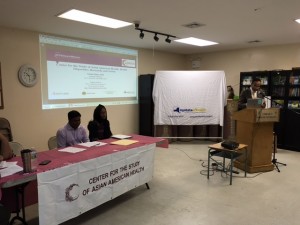India Home, which is an organization that serves South Asian seniors at its five centers in Queens, New York has had success getting its older adult clients to improve their health by using culturally competent methods. The positive change in attitudes toward disease management and healthy eating was brought about through the organization’s ongoing and successful partnership with New York University’s Center for the Study of Asian American Health (CSAAH). The Center is the leading institute in the US set up to study Asian American health. India Home’s collaboration with the institute helped facilitate several health projects that used culturally appropriate practices to focus on the health of Bengali seniors at the Desi Senior Center, India Home’s biggest center in Jamaica, Queens.

The team from CSAAH shares their findings with the seniors at India Home’s Desi Senior Center.
MD Taher is a Community Health Worker with CSAAH, who worked closely with Bangladeshi elders at the center. “There are serious health concerns in the community,” he said. South Asian elders have long experienced disparities in health and healthcare. One in four Bangladeshis have diabetes. One in five suffer from hypertension. Moreover, these communities have limited access to quality health care and often suffer from lack of language access. According to Taher, these projects fill a “necessary void in care.”
India Home also worked on the REACH FAR (Racial and Ethnic Approaches to Community Health for Asian Americans) program as a study implementation site for Keep On Track and nutrition strategies. Over 80 seniors from the Desi Senior Center participated in the project. Through the Keep On Track program, volunteers from India Home trained by CSAAH have been providing free monthly blood pressure screening and counseling to India Home’s clients.
Other projects too have had a direct impact on the health of our seniors. One helped to disseminate nutrition information with culturally and linguistically adapted brochures in Bengali and Hindi. “They [staff from CSAAH] came many, many times to the center to teach our seniors about nutrition. They gave them a cup and a spoon, taught them how to measure their food portions,” said Nargis Ahmed, the Site Director for Desi Senior Center. Ahmed, who is from a Bangladeshi background herself, worked closely with the team from CSAAH to get the Bangladeshi seniors to try these new healthful strategies.

Dr. Nadia Islam, PhD, the Deputy Director and co-investigator of the Center for the Study of Asian American Health presents findings on the DREAM Project to India Home’s elder clients.
Another important innovation has been CSAAH’s partnership with five pharmacies in the Jamaica area of Queens, New York, to create linguistically adapted health materials in Hindi and Bengali, the languages spoken by a large proportion of seniors in the area. These materials delivered vital information to seniors language they could understand, thus improving their chances of sticking to a drug or nutritional regimen.
CSAAH also launched a nutrition strategy by working with area restaurants like Star Kabab in Jamaica to replace ingredients in common dishes so as to make them healthier. For example, switching white rice with brown in kitchurie (a Bengali rice and lentil dish) increased its nutrition content. CSAAH has also partnered with local mosques to serve healthier foods for the iftar meal that breaks the Ramadan fast.
Other CSAAH projects like the DREAM (Diabetes Research, Education, and Action for Minorities) Coalition, a five-year community based participatory research study, have also had success in improving attitudes toward health in the Bangladeshi community. The DREAM project aims to develop, implement, and test a Community Health Worker (CHW) Program designed to improve diabetes control and diabetes-related health complications in the Bangladeshi community in New York City. As a result of this effort at diabetes management, over 400 patients (including many at the Desi Senior Center) who participated across the city, lost weight, became more active physically, managed their medications better and saw their doctors regularly.
By hosting and attending community health forums, India Home plays a key role in disseminating health messages to community members along with CSAAH. In 2016, India Home hosted the NYU CSAAH forum with participation from community members, researchers, media, and policy makers. The aim was to update the seniors who participated in the projects in the spirit of transparency and partnership, and create ongoing dialogue. “We wanted to tell the community what our findings were, and thank them,” MD Taher, the Community Health Worker said.
The response from the community of Bengali seniors has been encouraging. Even with barriers like work, taking care of grandchildren and busy lives, participants have been able to maintain the lifestyle changes they made as a result of the projects. In the face of the rapidly growing older adult population of Bengali seniors in New York City, India Home is making every effort to continue to be a leading resource not only to its senior clients, but also to the agencies and institutions that are working to respond to changing and emerging needs of the older adult Bengali population. The organization continues to link patients with culturally appropriate resources to provide support for disease and health management.
“Our seniors were very happy that they learned new things, and I plan to continue to remind them,” Nargis Ahmed said.
The opinions expressed in this article are those of the author and do not necessarily reflect those of the Diverse Elders Coalition.

